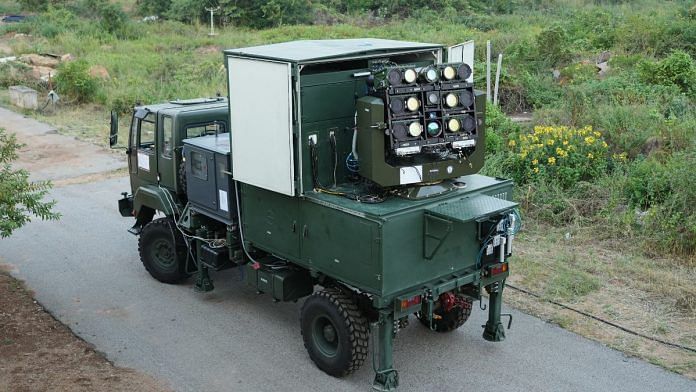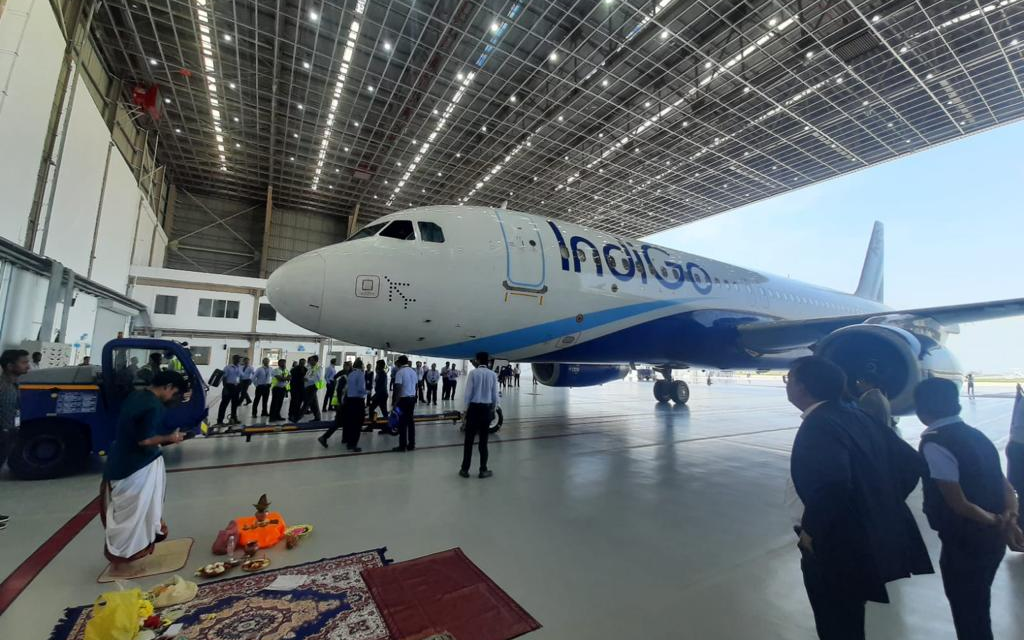AFI
SOURCE: AFI


The Indian Army has begun deploying loitering ammunition along the Line of Control (LoC) in response to a recent surge in Pakistani Army-assisted attempts to infiltrate terrorists into the Kashmir Valley. This strategic move, reported in early April 2025, aims to counter the escalating cross-border threats, particularly in sectors like Krishna Ghati and Akhnoor, where Pakistan’s Border Action Team (BAT) and terrorist groups have intensified their activities.
Loitering munitions, often dubbed “kamikaze drones,” offer a new layer of precision and persistence to India’s border security, reflecting a shift toward advanced technology to tackle asymmetric warfare. This article examines the deployment, its operational significance, and the broader context of India-Pakistan tensions along the LoC.
Continue readingSOURCE: AFI


Pipavav Shipyard, India’s largest shipbuilding facility located in Gujarat, is poised for a remarkable comeback under the stewardship of Swan Defence and Heavy Industries Ltd (SDHI), formerly Reliance Naval and Engineering Ltd. Vivek Merchant, Director of SDHI, recently announced that the shipyard is on track to resume shipbuilding operations within a couple of months, marking a significant milestone in its revival after years of financial and operational challenges.
Since SDHI took control of the shipyard on January 4, 2024, following its acquisition through a National Company Law Tribunal (NCLT) resolution process, the facility has already demonstrated its capabilities. Merchant highlighted the completion of repair and refit work on four vessels, including three for the Indian Coast Guard. “We actually completed three Coast Guard vessels. These are Fast Patrol Vessels (FPVs) and Offshore Patrol Vessels (OPVs). OPVs are the Coast Guard’s largest ships. So, we can now repair two OPVs. I think that is a good demonstration,” Merchant said. Notably, all three Coast Guard refits were delivered ahead of schedule, underscoring the shipyard’s renewed efficiency.
Continue readingSOURCE: AFI


In a bold step toward global expansion, Bengaluru-based space technology startup Bellatrix Aerospace has announced plans to establish a propulsion systems manufacturing facility in Delaware, USA, to serve the burgeoning U.S. commercial space market. The move, unveiled on April 11, 2025, underscores India’s growing influence in the global aerospace sector and positions Bellatrix as a key player in sustainable space propulsion technology.
Bellatrix has already secured a significant partnership by signing a Memorandum of Understanding (MoU) with a prominent U.S. satellite manufacturer, positioning itself as their preferred propulsion partner. While details of the partner remain undisclosed, this collaboration highlights confidence in Bellatrix’s innovative technologies, which include high-performance green propulsion systems and electric Hall-effect thrusters. These systems, known for their reliability and cost-efficiency, are tailored to meet the demands of modern satellite constellations.
Continue readingSOURCE: AFI


In a significant boost to the Indian Navy’s modernization efforts, German engine manufacturer MAN Energy Solutions (MAN ES) has secured a contract to supply advanced propulsion packages for five new Fleet Support Ships (FSS). The deal, signed with Hindustan Shipyard Limited (HSL), underscores India’s commitment to enhancing its maritime capabilities with cutting-edge technology. Announced on April 15, 2025, this contract marks a milestone in the Indian Navy’s journey toward self-reliance and operational excellence.
The contract includes the delivery of ten 20V32/44CR marine engines, which will serve as the heart of the propulsion systems for the five FSS vessels. These engines, among the largest ever supplied to the Indian Navy, are complemented by main reduction gearboxes, shaft generators, bow thrusters, and MAN Alpha Navy Controllable Pitch Propeller (CPP) systems. The 32/44CR engines are renowned for their reliability and efficiency, making them a trusted choice for medium-speed marine diesel applications in naval fleets worldwide.
Continue readingSOURCE: AFI


India has solidified its place among the world’s leading defense innovators with the successful development of the Gaurav, a 1,000 kg-class Long-Range Glide Bomb (LRGB) that stands out as one of the few purpose-built heavy glide bombs globally. Designed and developed by the Defence Research and Development Organisation (DRDO), Gaurav combines advanced GPS-guided precision with an impressive 100-kilometer range, setting a new benchmark for India’s indigenous defense capabilities. Conducted between April 8-10, 2025, its recent trials from a Su-30 MKI fighter jet demonstrated pinpoint accuracy, marking a significant leap for the Indian Air Force (IAF).
Unlike most glide bombs, which typically fall into the 500 kg category due to the aerodynamic and structural complexities of heavier designs, Gaurav’s 1,000 kg payload places it in an elite class. Its closest counterparts include the U.S.-made Joint Direct Attack Munition-Extended Range (JDAM-ER) and Israel’s SPICE-2000, both renowned for their precision and extended reach. However, Gaurav’s fully indigenous development, involving DRDO’s Research Centre Imarat, Armament Research and Development Establishment, and industry partners like Adani Defence and Bharat Forge, underscores India’s growing self-reliance in cutting-edge military technology.
Continue readingSOURCE: AFI


India’s quest for self-reliance in aerospace technology hinges on the successful development of indigenous jet engines, a domain where the Gas Turbine Research Establishment (GTRE), under the Defence Research and Development Organisation (DRDO), has been striving for decades. The Kaveri engine program, its successor Kaveri 2.0, and the ambitious Advanced Medium Combat Aircraft (AMCA) engine project are pivotal to reducing India’s dependence on foreign engines. A critical enabler for these programs is a dedicated Flying Testbed (FTB), a specialized aircraft used to evaluate engine performance under real-world flight conditions.
With Tata Group-owned Air India auctioning its last Boeing 747 (registration VT-ESO) on May 6, 2025, in Mumbai, the question arises: Should GTRE seize this opportunity to acquire the aircraft as an FTB for its engine development programs?
Continue readingSOURCE: AFI


The recent downing of Ukrainian Su-27 and F-16 jets by Russia’s S-400 Triumf air defense system has sent ripples through global defense circles, serving as a potent reminder of the system’s formidable capabilities. For the Pakistan Air Force (PAF), heavily reliant on its aging fleet of F-16s and JF-17s, this development underscores a critical reality: approaching India’s borders, fortified by the same S-400 systems, has become a near-impossible task.
India’s strategic deployment of the S-400 along its western frontier demands a serious recalibration of Pakistan’s aerial tactics, as the system’s proven lethality redefines the subcontinent’s air defense dynamics.
Continue readingSOURCE: AFI


Recent statements from Pakistani military leaders and politicians reveal a troubling narrative: a call to lead Arab forces in a supposed conquest to reclaim what they term “Islamic land” from Israel and India, dismissing the two-state solution for Palestine and framing Kashmir as a religious battleground. This rhetoric, rooted in ideological fervor rather than strategic reality, exposes a fallacy in Pakistan’s military thinking—that it can succeed where Arab coalitions have failed over seven decades against Israel, while simultaneously challenging India over Kashmir. Such ambitions risk overextending Pakistan’s capabilities, misreading global geopolitics, and plunging the region into deeper instability.
Pakistan has historically supported the Palestinian cause, advocating for a state based on pre-1967 borders with East Jerusalem as its capital. However, recent pronouncements from military figures, including corps commanders’ meetings reported on April 4, 2025, express “complete solidarity” with Palestinians while condemning Israel’s actions as “war crimes.” More alarmingly, some statements from political and religious leaders, like those at Jamaat-e-Islami rallies, imply a rejection of the two-state solution, favoring a total reclamation of Palestinian territory as “Islamic land.” This aligns with a broader narrative of leading a pan-Islamic military effort against Israel, a role Pakistan’s army seems increasingly eager to embrace.
Continue readingSOURCE: AFI


In a landmark achievement for India’s defense capabilities, the Defence Research and Development Organisation (DRDO) successfully tested and showcased a 30-kilowatt (kW) laser-based Directed Energy Weapon (DEW) on April 13, 2025, at the National Open Air Range (NOAR) in Kurnool, Andhra Pradesh. This breakthrough, which demonstrated the weapon’s ability to neutralize aerial threats like fixed-wing drones, swarm drones, and surveillance sensors with pinpoint precision, has propelled India into an elite group of nations mastering advanced laser technology, alongside the United States, China, and Russia.
Developed by DRDO’s Centre for High Energy Systems and Sciences (CHESS) in Hyderabad, in collaboration with other DRDO labs, academic institutions, and Indian industries, the Mk-II(A) DEW system showcased its full spectrum of capabilities. The 30 kW laser, comprising six 5 kW lasers converging into a single high-energy beam, engaged targets at a range of up to 5 kilometers, inflicting structural damage and disabling sensors in seconds. Equipped with a 360-degree Electro-Optical/Infrared (EO/IR) sensor, the system ensures rapid, silent, and cost-effective neutralization of threats, with operational costs likened to “a couple of liters of petrol” per shot.
Continue readingSOURCE: AFI


The Indian Navy’s ambition to expand its fleet to 175–200 warships by 2035 is a bold vision, driven by the need to counter growing maritime threats, particularly from China’s expanding naval presence in the Indian Ocean. However, achieving this goal is increasingly at risk due to the Ministry of Defense’s (MoD) persistent preference for state-owned shipyards over private ones.
As highlighted in a 2022 Defense News report, the Indian Navy is unlikely to meet its fleet expansion targets due to funding constraints and the government’s bias toward public sector shipyards, which has left private players like Pipavav Shipyard (now under Swan Defence and Heavy Industries Ltd) struggling to secure contracts. It is time for the MoD to reverse this trend and actively encourage private sector shipyards to develop warships, leveraging their potential to boost capacity, innovation, and efficiency.
Continue readingSOURCE: AFI


On April 14, 2025, two Bengaluru-based startups, QpiAI and QNu Labs, unveiled groundbreaking quantum technology platforms, cementing India’s growing presence in the global quantum race. The launches, coinciding with World Quantum Day, were reported by Deccan Herald on April 16, 2025, highlighting a 25-qubit quantum computer by QpiAI and a quantum-safe cryptography solution, QShield, by QNu Labs.
These developments, celebrated by Union Minister Dr. Jitendra Singh and Karnataka’s IT Minister Priyank Kharge via posts on X, showcase Bengaluru’s role as a hub for deep-tech innovation and align with India’s National Quantum Mission (NQM) to advance quantum research and applications.
Continue readingSOURCE: AFI


In a significant development for India’s aviation sector, carriers like Air India Express and Akasa Air stand to gain from China’s recent directive to its airlines to halt Boeing aircraft deliveries, a move prompted by escalating trade tensions with the United States. According to a report by The Times of India on April 16, 2025, this decision, driven by U.S. tariffs imposed by President Donald Trump, could redirect Boeing’s production capacity toward Indian airlines, bolstering their fleet expansion plans at a time when India’s aviation market is soaring.
China’s order to suspend Boeing jet deliveries and halt purchases of U.S.-made aircraft parts follows Trump’s imposition of tariffs up to 145% on Chinese goods, as reported by Bloomberg on April 15, 2025. In retaliation, China announced 125% tariffs on American products, effectively doubling the cost of U.S.-made aircraft and components for its carriers. This has led Chinese airlines, including major players like Shanghai Airlines, to pause Boeing deliveries, creating a surplus of undelivered aircraft, particularly the Boeing 737 Max.
Continue readingSOURCE: AFI


In a landmark move for India’s defence sector, the JCBL Group, through its defence arm Airbornics Defence & Space Pvt Ltd (ADSL), has signed India’s first-ever defence Memorandum of Understanding (MoU) with Slovakia. Formalized during President Droupadi Murmu’s state visit to Slovakia in August 2024, this pioneering agreement, announced on April 15, 2025, focuses on co-developing advanced technologies for light tanks, Future Ready Combat Vehicles (FRCVs), and Futuristic Infantry Combat Vehicles (FICVs).
The partnership, aligning with the “Make in India” initiative, will see ADSL manufacture cutting-edge systems, including turrets, Remote-Controlled Weapon Systems (RCWS), and Active Protection Systems (APS), entirely in India, reinforcing the nation’s push for self-reliance in defence manufacturing.
Continue readingSOURCE: AFI


In a strategic push to bolster India’s aerospace sector, the government is crafting a comprehensive roadmap to enhance aircraft component manufacturing, aiming to position the country as a global hub for aviation supply chains. The initiative focuses on easing regulatory norms, providing robust research and development (R&D) support, and addressing critical industry needs to foster innovation and scalability.
The roadmap comes at a time when India’s aerospace ecosystem is gaining global attention. Industry giant Boeing already sources components worth over $1.25 billion annually from more than 300 Indian suppliers, including numerous micro, small, and medium enterprises (MSMEs). These partnerships underscore India’s growing expertise in manufacturing precision parts, ranging from aerostructures to avionics, and highlight the potential for further expansion.
Continue readingSOURCE: AFI


Hindustan Aeronautics Limited (HAL) has embarked on a transformative journey by commencing the overhaul of Airbus A320 family aircraft at its state-of-the-art Maintenance, Repair, and Overhaul (MRO) facility in Ozar, Nashik, Maharashtra. This milestone, announced on April 15, 2025, marks HAL’s first foray into civilian aircraft maintenance, expanding beyond its traditional role of servicing military aircraft like the Sukhoi Su-30 MKI. The successful delivery of an overhauled A320 Neo to IndiGo in March 2025, alongside ongoing work on two Embraer aircraft, underscores HAL’s growing prowess in the commercial aviation sector, aligning with the “Make in India” initiative and bolstering India’s aviation ecosystem, as reported by Aviation A2Z.
HAL’s venture into civilian MRO services stems from a landmark contract signed with Airbus in November 2023, establishing a C-check facility for the A320 fleet in Nashik. The facility, operational by November 2024 after securing Directorate General of Civil Aviation (DGCA) approval, is designed to meet both DGCA and European Aviation Safety Agency (EASA) standards. Airbus has played a pivotal role, supplying the A320 family tool package, providing access to its AirbusWorld digital platform, and conducting gap assessments and upskilling workshops for HAL’s workforce. These efforts included tailored recommendations for facility upgrades and specialized training, such as BAMEC certification and Level-III A320 type courses in collaboration with IndiGo, ensuring world-class maintenance standards.
Continue reading